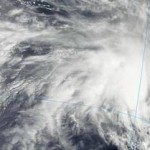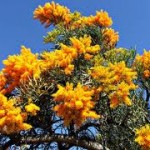 Summer
Summer
Summer is the warmest of the four temperate seasons, between spring and autumn. At the summer solstice, the days are longest and the nights are shortest, with day-length decreasing as the season progresses after the solstice. The date of the beginning of summer varies according to climate, culture, and tradition, but when it is summer in the Northern Hemisphere it is winter in the Southern Hemisphere, and vice versa.
  Australia Day, 26/1/2012, Perth, Western Australia
   Cyclone Iggy, North West Australia
Trachymene coerulea
   Nuytsia floribunda   
From an astronomical view, the equinoxes and solstices would be the middle of the respective seasons, but a variable seasonal lag means that the meteorological start of the season, which is based on average temperature patterns, occurs several weeks later than the start of the astronomical season. According to meteorologists, summer extends for the whole months of June, July, and August in the northern hemisphere and the whole months of December, January, and February in the southern hemisphere. Under meteorological definitions, all seasons are arbitrarily set to start at the beginning of a calendar month and end at the end of a month. This meteorological definition of summer also aligns with the commonly viewed notion of summer as the season with the longest (and warmest) days of the year (365 days), in which daylight predominates. The meteorological reckoning of seasons is used in Austria, Denmark and the former USSR; it is also used by many in the United Kingdom, where summer is thought of as extending from mid-May to mid-August. In Ireland, the summer months according to the national meteorological service, are June, July and August. However, according to the Irish Calendar summer begins 1 May and ends 1 August. School textbooks in Ireland follow the cultural norm of summer commencing on 1 May rather than the meteorological definition of 1 June.
From the astronomical perspective, days continue to lengthen from equinox to solstice and summer days progressively shorten after the solstice, so meteorological summer encompasses the build-up to the longest day and a diminishing thereafter, with summer having many more hours of daylight than spring. Solstices and equinoxes are taken to mark the mid-points, not the beginnings, of the seasons. Midsummer takes place over the shortest night of the year, which is the summer solstice, or on a nearby date that varies with tradition.
The Western definition based on solstice to equinox is more frequently used where a temperature lag of up to half a season is common. In North America, summer is often the period from the summer solstice (usually June 20 or 21 in the Northern Hemisphere) to the autumn equinox.  Unofficially, the U.S. summer season is commonly regarded as beginning on Memorial Day weekend (the last weekend in May) and ending on Labor Day weekend (the first weekend in September), more closely in line with the meteorological definition.
In Chinese astronomy ¬†summer starts on or around 5 May, with the ji√©q√¨ (solar term) known as l√¨xi√† (Áę茧Ź), i.e. “establishment of summer”, and it ends on or around 6 August.
In southern and southeast Asia, where the monsoon occurs, summer is more generally defined as lasting from March to May/early June, their warmest time of the year, ending with the onset of the monsoon rains.
Because the temperature lag is shorter in the oceanic temperate southern hemisphere[ most countries in this region, especially Australia and New Zealand, use the meteorological definition with summer starting on December 1 and ending on the last day of February.
Wet season thunderstorm at night in Darwin, Australia.
Summer is traditionally associated with hot dry weather, but this does not occur in all regions. In areas of the tropics and subtropics, the wet season occurs during the summer. The wet season is the main period of vegetation growth within the savanna climate regime. Where the wet season is associated with a seasonal shift in the prevailing winds, it is known as a monsoon.
Image of Hurricane Lester from late August 1992.
In the Northern Atlantic Ocean, a distinct tropical cyclone season occurs from 1 June to 30 November. The statistical peak of the Atlantic hurricane season is 10 September. The Northeast Pacific Ocean has a broader period of activity, but in a similar time frame to the Atlantic. The Northwest Pacific sees tropical cyclones year-round, with a minimum in February and March and a peak in early September. In the North Indian basin, storms are most common from April to December, with peaks in May and November. In the Southern Hemisphere, the tropical cyclone season runs from 1 November until the end of April with peaks in mid-February to early March.
In the interior of continents, thunderstorms can produce hail during the afternoon and evening. Schools and universities typically have a summer break to take advantage of the warmer weather and longer days.
In most countries children are out of school during this time of year for summer break, although dates vary. In the Northern hemisphere, some begin as early as May, although in England and Wales school ends in mid- to late July. In the Southern hemisphere, school holiday dates include the major holidays of Christmas and New Year’s Day. Summer school holidays in Australia begin just before Christmas and end in late January to mid-February, with the dates varying between states.
People take advantage of the warmer temperatures by spending more time outdoors during the summer. Activities such as traveling to the beach and picnics occur during summer months. Sports such as cricket, volleyball, skateboarding, baseball, softball, Canadian football, tennis and water polo are played. Water sports also occur. These include water skiing, wake boarding, swimming, and tubing. Water skiing is a uniquely summer sport, which is done when waters approach their warmest of the year. The modern Olympics have been held during the summer months every four years since 1896.
Summer is usually a low point in television viewing, and television schedules generally reflect this by not scheduling new episodes of their most popular shows between the end of May sweeps and the beginning of the television season in September, instead scheduling low-cost reality television shows. Conversely, the music and film industries generally experience higher returns during the summer than other times of the year and market their summer hits accordingly.
With most school-age children and college students on summer vacation during the summer months, especially in the United States, travel and vacationing traditionally peaks during the summer, with the volume of travel in a typical summer weekend rivaled only by Thanksgiving. Teenagers and college students will often take summer jobs in industries that cater to recreation.
(Ref: wikipedia.org)








